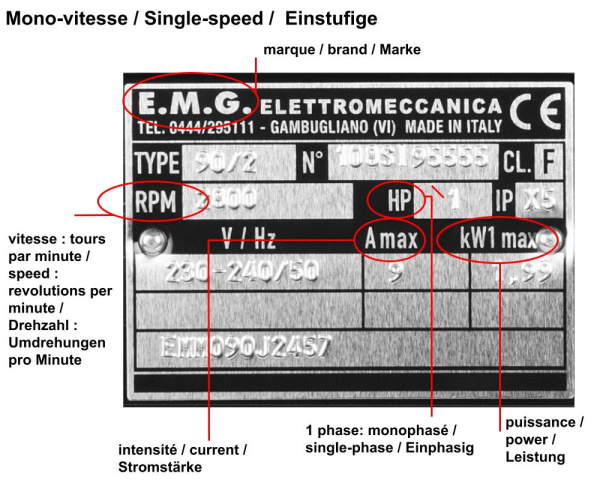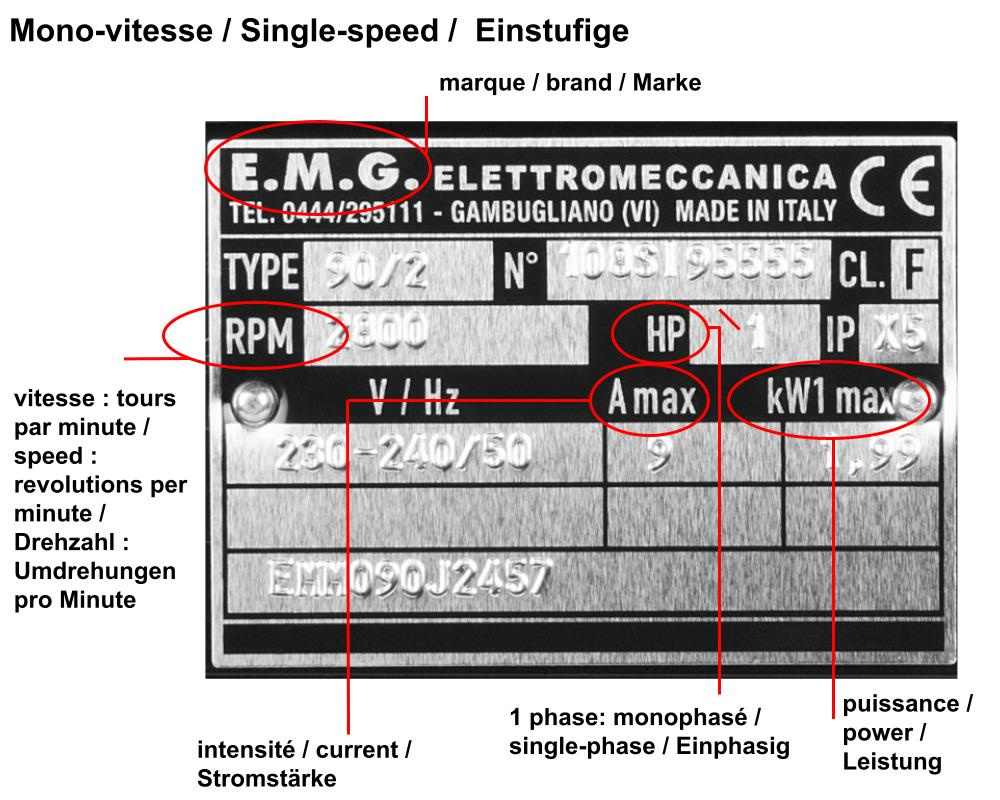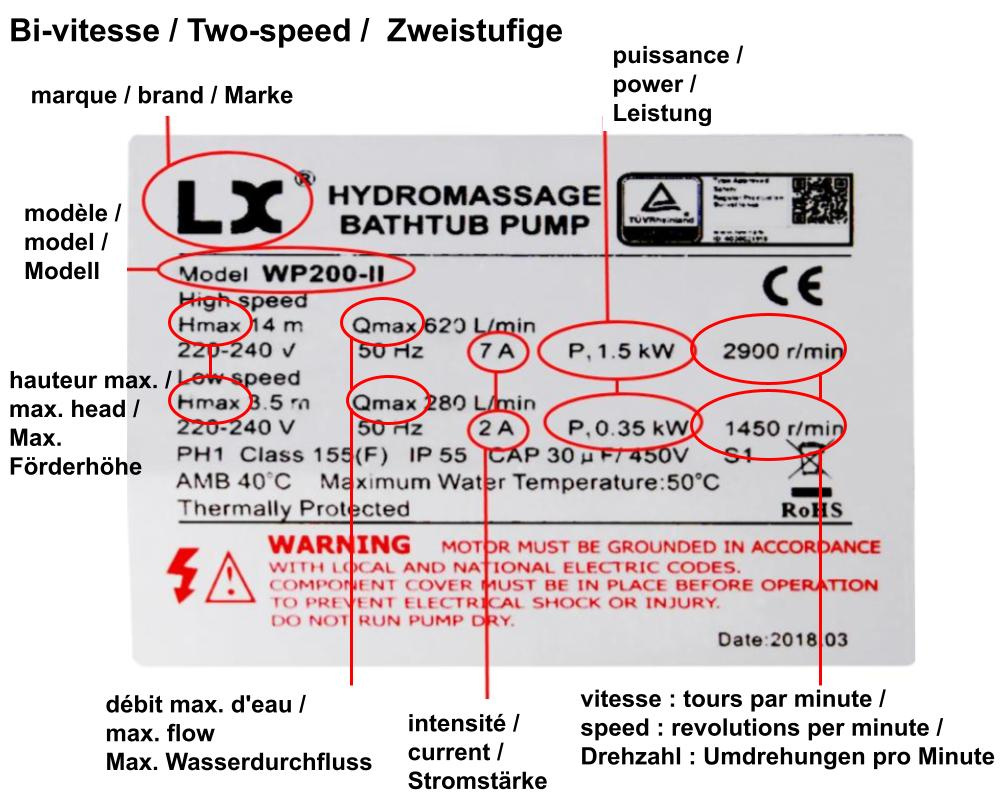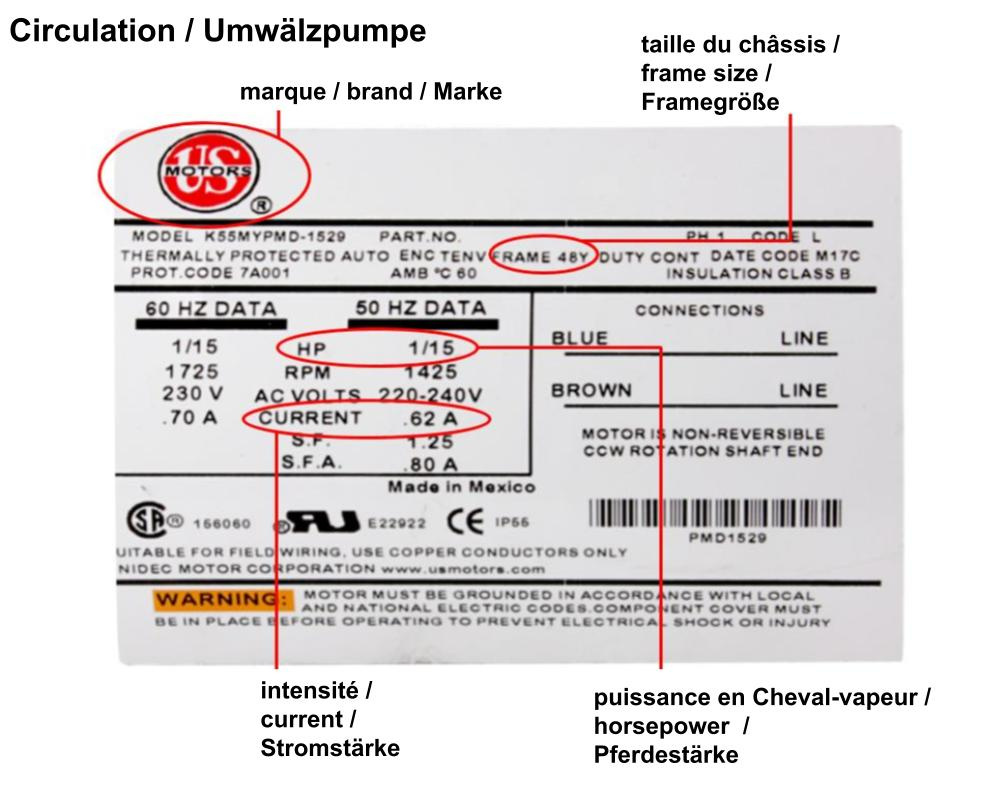How to read pump labels
If you want to replace your pump, you’ll need more information than just the brand of your spa. A same spa may have been built with spare parts from different brands throughout the years, and the manufacturer might choose to install a circulation pump from Waterway one year and one from Aqua-Flo the next.
"Pump" manufacturers mainly produce its hydraulic part - the pump body - and buy the motor elsewhere (e. g. Waterway pumps usually have a motor from the italian manufacturer EMG). This means that you can find labels or plates from both the motor manufacturer and labels from the pump manufacturer.
The dimensions of the pump and/or the wet end to be changed are obviously important, but the informations on the label on the motor (or occasionally the wet end) even more so: they give you the brand of the pump or the motor, the model, the type (single or two-speed), the power, etc.
These informations can sometimes be difficult to understand, so we have listed, depending on the type and brand of the most common pumps on the market (see pictures opposite), the important elements to know in order to find the pump (or a similar one) on our website.
The essential information
Manufacturer
Brand names are usually on the motor plate and/or on a label on the electrical box or the fan cover of the pump. Because pump manufacturers buy electric motors from other companies, you may find not the brand name for the pump (Waterway, Aqua-Flo, LX Whirlpool, Espa, etc.), but also for the motor (like E.M.G., US Motor or AO Smith). Motors from competing motor manufacturers are quite interchangeable, and most pump manufacturers have worked with most major motor manufacturers over the years, so knowing that your pump has an AO Smith motor is not as useful as you might think. Lots of different pumps use AO Smith motors, and your ideal replacement pump might actually use a different motor. The information that you really need is the brand of the pump itself, if possible. If you are not sure, please send us a photo of the pump wet end.
Model
Manufacturers give pumps names, like XP3, Executive and Niagara. The name typically applies to an entire range of pumps, which include both one-speed and two-speed versions, and different power ratings. Knowing the pump model name is a good start, but you will still need more information.
Power rating
Remember that Power (W) = Voltage (V) ✕ Current (A)
The power is typically indicated in Watts (W or kW), and/or HP (for horsepower) on the motor. In theory you can convert between Watts and HP (1 HP = 750 W), but in many cases the power indicated in HP has become meaningless from a technical point of view. When you see a pump labelled as 1 HP, think of it as the name of the pump variant, and a very rough indication of its power, but it does not necessarily mean that the power is 750 W.
If you do not have a power expressed in W, you can calculate it from the current, expressed in amperes (A). Since all spa pumps run on 220-240V, you can multiply the current listed on the motor by 230 to get an approximate indication of the pump power in Watts. A pump motor that lists a nominal current of 10 A, for example, has a power rating of approximately 10 ✕ 230 = 2300 W.
Type of motor
If you see a single power rating on the pump label (or potentially two ratings that are very similar to one another), it probably indicates that you have a single-speed pump. If you see two very different power ratings (e. g. 2 kW / 0.4 kW), then you have a two-speed pump.
You will also know that you have a two-speed pump if it is powered by a four-wire cable instead of three, because there is one live wire for each speed of the motor (the other two cables are the neutral, which is used for both speeds, and the earth).
Other useful information
Rotation speed
The motor speed is expressed in revolutions per minute (rpm). Tubs Parts only offers 50 Hz single-phase pumps, for which there are only two standard rotation speeds:
- Approximately 2800-2900 rpm, for 2-pole motors
- Approximately 1400-1450 rpm, for 4-pole motors
Small variations around these values are not important. Your old pump could indicate a speed of 2900 rpm, but that doesn't prevent you from replacing it with a pump that says it runs at 2800 rpm.
Essentially all hot tub massage pumps use 4-pole motors, so they run at around 2850 rpm. Some circulation pumps use 2-pole motors (~1425 rpm) and some use 4-pole motors. Pumps that turn at the lower speed are generally quieter. Two-speed pumps can flip between 2-pole and 4-pole configurations.
There are exceptions, of course. Hot tubs are occasionally (rarely) equipped with three-phase pumps, or variable-speed pumps. If in doubt, contact us.
Frame size
The frame size refers to the spacing between the four bolts that attach the wet end to the motor. The most common frame sizes for hot tub pumps are 48-Frame and 56-Frame. You will need this information if you wish to repair your pump by replacing the wet end while keeping the same motor (or vice versa).
Voltage and frequency
All the pumps offered on Tubs Parts are designed for use with European mains electricity, i. e. 220-240V at 50 Hz. If you have a pump that is designed for 60 Hz or with a different voltage (110V or 400V, for example), contact us.
Water and dust resistance, IP
A protection index, written on all pump labels with the acronym "IP", indicates the level or resistance to water and dust penetration. The IP is a two-digit number that indicates the degree of resistance to solid substances, such as dust (first digit) and liquids (second digit).
- An IPX5 protection rating (photo 1) means that the operation of the pump does not imply the need to protect it against the intrusion of solids, and that it is protected against water jets with a hose.
- An IP55 protection rating (photos 2 and 3) means that the pump is protected against dust deposits, and that it is protected against water jets with a hose.
Maximum flow rate, Qmax
The "Qmax" value on some pumps corresponds to the maximum water flow rate, in m³/hour, litres/minute or gallons/minute (GPM), which can be supplied by the pump with a minimum of resistance. 1 US gallon = 3.8 litres.
Maximum resistance, Hmax
Some labels indicate "Hmax", followed by a value in metres or feet (1 foot = 0.3 metres). This value represents the maximum resistance of the circuit for which the pump was designed. The higher this value, the more the pump will be able to force water over long distances and through small pipes and nozzles, and the more it will be able to raise the water above the pump level (hence the Hmax value expressed in meters). Each length of pipe, elbow, filter, heater and jet increases the resistance of the circuit, and will reduce the flow rate.



